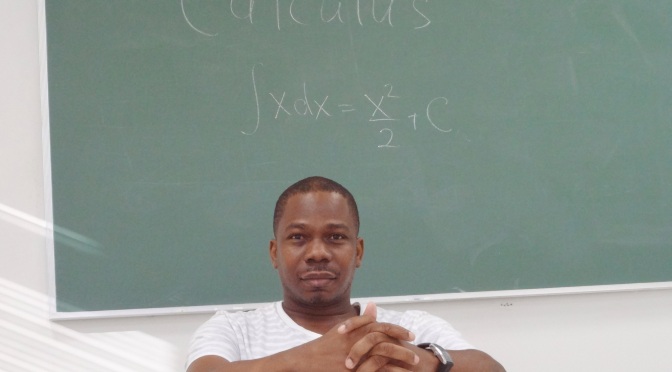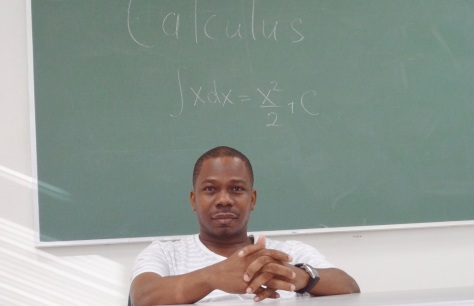It was one gunshot. Lenora Rochester was in her Contant Knolls apartment on St. Thomas, U.S. Virgin Islands when she heard the sound on that Thursday evening of Dec. 10, 2015. She was not very alarmed, as gunshots are heard in the neighborhood from time to time. But a few moments later came knocks to her front door – and her life changed forever. The news was devastating. Her son Kadeem John Sr. was shot. Rochester woke her daughter and they hurried to find John.
“When I walked out (the apartment) I didn’t have any emotions or feelings,” Rochester says. Her only thought was “I can’t believe he got shot.”
When Rochester arrived at the scene and saw someone holding pressure to her son’s bleeding chest it became real. “He looked lifeless,” she remembers. “I started to cry.” Between her uncontrollable tears while making calls to notify family members, a police officer put her in his patrol car. “I kept asking ‘is he ok, is he ok,’” she recalls. The only response was “stay in the car,” she says. She stayed put then the ambulance arrived. But instead of driving behind of the ambulance to the hospital as Rochester imagined, she heard something over the police scanner. “They (the EMTs) radioed for the medical examiner,” Rochester says. “I realized that he was gone.” She jumped out of the car to see her son. “I was trying to go to the body, they (police officers) were pulling me back. They said it was a crime scene.”
In that moment Rochester says she felt a rush of emotions – the most dominant being anger. “I was angry,” she recalls. “I was totally angry.”
Rochester describes her third son as a “fun child” who was always smiling – so much so that his friends gave him the nickname “Smiley.” He never got into trouble and had no apparent enemies, Rochester says, so she couldn’t imagine why anyone would kill him. A mariner with the Merchant Marines, John lived mostly on a ship at sea. He had come back to St. Thomas for holiday break. The family spent Thanksgiving in Puerto Rico. John returned to St. Thomas on a Tuesday. He spent the next Thursday at his aunt’s home and was returning to his mom’s home the evening when he was killed.
With support from family and friends, Rochester made it through to Dec. 23, when she laid John to rest – just a day before he would have made 24 years old. “It was just sad,” Rochester says of burring her son. “It was terrible. I was just crying a lot.” On Dec. 24, members of John’s 2009 graduating class of Ivanna Eudora Kean High School held a candlelight vigil at the spot where he was killed. It was then that Rochester began her fight for justice for John.
As homicides continue to rock the territory, Virgin Islands Police Department Commissioner Delroy Richards held a press briefing to address the issue following the July 30, killing of Bria Evans. At the Aug. 1, briefing Richards confirmed 36 homicides in the American territory. The number continues to grow: two police officers were discovered shot to death on Aug. 11 and a firefighter was shot to death on Aug. 19. The national murder rate is 4.5 killings per 100,000 people per year. At 39 homicides so far, the U.S. Virgin Islands – home to about 103,000 residents, is one of the most murderous places in the United States.
The homicide problem in the territory is multilayered. Many people point to the infiltration of guns into the territory along with the retaliatory nature of gun crimes.
Psychologist Anissa Moody says the problem in the Virgin Islands rests on two major issues: poverty and a distorted view of masculinity.  Young men are not given a healthy understanding of masculinity, says Dr. Moody, a professor of psychology at the City University of New York.
Young men are not given a healthy understanding of masculinity, says Dr. Moody, a professor of psychology at the City University of New York.
Often Caribbean and West Indian masculinity don’t allow men to experience and express a range of emotions, she explains. The males are “angry and aggressive or not,” she says, and emotions are not largely communicated. The community has no rituals around the development of young men, where they are taught a sense of self and expectations are set, she continues. Toughness – and in extreme cases violence – is seen as the foundation of manhood. Many young men are ill equipped to handle conflict and manage their emotions. That, coupled with easy access to firearms, results in a vicious cycle of violence that cripples the entire community.
At the briefing Commissioner Richards confirmed the “retaliatory trend that exists in the territory” asserting that, “someone that the victim is close to will retaliate.”
In the minds of many young men “death doesn’t seem that bad. Your masculinity means that you fight to the end,” says Dr. Moody, who is also columnist for Ebony magazine and BlackDoctor.com. “Adults glorify these deaths by how we respond,” she says, noting that along with the rest in peace hashtags on social media victims are often remembered as “soldiers.”
“The violence is not experienced as loss,” Dr. Moody explains. “There is no ritual around it. The ritual becomes revenge,” she says. “Each death triggers another death and reaffirms this feeling of helplessness. Because of how often it happens, the more likely it is to happen,” she explains. “The worst part is that this is part of the community behavior. It’s part of the ritual of development for many boys in our community. It’s what we do. It’s part of our life rituals. It’s a cycle.”
The more killings happen, the more the community becomes numb and less likely to take action, Dr. Moody says. “People think that repeated experiences (of violence) will sensitize you. It doesn’t. It does the opposite. It desensitizes you,” asserts Dr. Moody who was born on St. Thomas and raised on St. Croix.
The parents, children, spouses, siblings, and friends who are left to bury the victims of gun violence often deal with their pain by hiding their emotions. Trauma after trauma has created a collective “emotional grave yard” in the Virgin Islands, Dr. Moody says. Not to mention the cumulative loss of potential that dies each time someone is killed.
Psychologist Carla Hunter says that the grief response is individual – the stages and length of time are different for each person. The stages of grief are denial and isolation, anger, bargaining, depression and acceptance. Studies show that the grief response to violent death has an added component. The study “Trauma and bereavement: examining the impact of sudden and violent deaths” by Stacy Kaltman and George A. Bonanno, reveals a correlation between violent death and posttraumatic stress disorder (PTSD). According to the study “violent death results in the development of PTSD symptoms over and above the normal grief response and thus may contribute to a more severe grief response.”
According to the National Center for PTSD, symptoms of the disorder include reliving the event, avoiding situations that remind you of the event, negative changes in beliefs and feelings, and feeling keyed up (hyperarousal).
As Virgin Islanders deal with trauma at home, they are also confronted with trauma on the mainland. Recent killings of African-Americans by police officers, many of the scenes caught on camera and shared on social media, is dealing a double whammy on the psyche of many.
Watching these acts repeatedly on the television and social media “can take over you,” and induce anger says Dr. Kia Fisher, a clinical therapist at Potter’s House Treatment Center in Atlanta. “We have to take a break from it (watching traumatic videos),” Dr. Fisher adds. She points out that she is not suggesting that the community ignores the problem. Dr. Fisher suggests people who feel anger should redirect their emotions to empowerment by taking positive action. “Take baby steps toward change,” she says.
Dr. Moody says too many people in the territory are stuck at the individual level when it comes to problem solving. “This is a community sickness, this type of development in our young men,” she says, suggesting that the community unites to bring about healing. “You know what we can do about it,” she asks. “Take action,” she says. Do not accept things as how they are, she says. The shift in masculinity should start at home and extend into the schools. Children, especially boys, should be reaffirmed with a sense of identity and purpose.
“We tend to reaffirm overt talents,” in sports, academics and music, Dr. Moody notes, but all children should be reaffirmed for their potential. While constantly being reaffirmed, children must be provided with positive opportunities for development and growth. Leaders must emerge for the community organizing necessary to connect resources.
Regarding poverty – the other main contributor to violence – elected officials must work to bring about economic prosperity in the territory. The correlation between poverty and crime is proven. The higher the poverty level, the more crime. Additionally, youth programs need to be funded, expanded and duplicated throughout the territory Dr. Moody says. Resources must be provided to parents, especially single parents. Parents should also be vocal about what the community needs, she adds.
Drs. Moody, Hunter and Fisher all suggest that people feeling overwhelmed by traumatic events should seek professional help.
“People don’t have to be in crisis to seek help,” says Dr. Hunter, a professor at the University of Illinois at Urbana-Champaign. “When you realize that you’re behaving in a way or thinking in a way that’s not typical for you, you should seek help.”
Dr. Moody takes it a step further, encouraging everyone to practice “good mental hygiene.” Just like most people have a primary physician, “everyone should have a mental health provider,” Dr. Moody says.
Rochester says her coping mechanisms have been prayer, support from family and friends, and “taking it one day at a time.” While she’s returning to a new normal, the loss of her son is still hard to process. “I’m still in disbelief,” she says.
From the day of John’s candlelight vigil, Rochester launched a personal campaign to bring “Justice for Kadeem.” On the 10th and 23rd of each month – the day John was killed and buried, respectively – Rochester takes to social media. Some of her posts are in remembrance, but most have been asking witnesses of the crime to step forward.
In recent movement of the case, the Governor of the Virgin Islands signed documents to have the suspect in John’s killing extradited from New York to stand trial. Part of the shock for Rochester was learning that the suspect knew her son. “It hurts. Everything was hurtful,” she says.
Because extradition is just the first step, Rochester continues to “hold the faith” that justice will eventually be served. In the meanwhile, she tries her best to “keep it together” for her other children and John’s son – Kadeem John Jr.
Rochester says she is no longer angry, but the pain of losing a child to senseless gun violence hasn’t gone away. “I’m still sad,” she says. “I don’t know if I’ll ever get over it.”





 Young men are not given a healthy understanding of masculinity, says Dr. Moody, a professor of psychology at the City University of New York.
Young men are not given a healthy understanding of masculinity, says Dr. Moody, a professor of psychology at the City University of New York.







